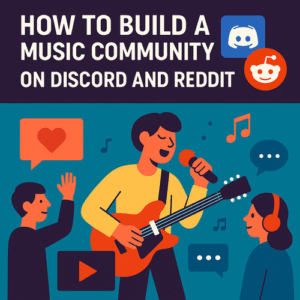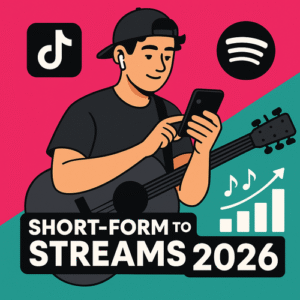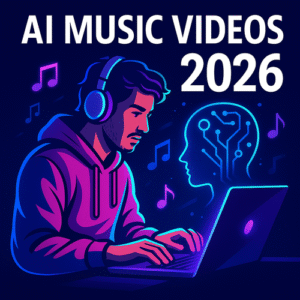Spotify has over 600 million active users globally, and its growth shows no signs of slowing down. What makes Spotify so valuable for artists isn’t just its reach — it’s the way its algorithm rewards engagement.
Spotify thrives on curated discovery. Whether through algorithmic playlists like Discover Weekly and Release Radar, or user-curated lists, the platform is built to help people find new music they’ll love.
The benefit for artists is simple: once you gain traction, Spotify does the heavy lifting. The more real listeners you attract, the more exposure you get automatically.
Key Strengths:
- Powerful algorithmic promotion through playlists
- Long-term fan retention via saves and follows
- Integrated artist tools for data tracking and growth
- Passive listening experience (users keep streaming even when inactive)
Main Challenge:
Spotify is purely audio-based. That means you need to rely heavily on artwork, metadata, and playlist placements to stand out — visual storytelling is limited.
The Power of YouTube Music in 2026
YouTube remains the world’s most-used platform for music discovery, with over 2 billion logged-in users every month. But in 2026, its role has evolved beyond traditional music videos — it’s now a hybrid of visual, social, and algorithmic discovery.
Short-form video (YouTube Shorts) plays a massive role in helping new songs go viral. Artists can release teasers, lyric clips, and behind-the-scenes content that drives massive engagement — something Spotify can’t match.
YouTube’s integration with AI-generated visuals, interactive content, and creator collaborations has also made it the most dynamic platform for visual branding.
Key Strengths:
- Viral potential through video and Shorts
- Visual storytelling for emotional connection
- Comment sections and community interaction
- Ad-based monetization and discovery crossover with YouTube Music
Main Challenge:
While YouTube is great for visibility, converting those views into long-term fans (and monthly listeners) can be harder than on Spotify.
Algorithm Comparison: YouTube vs Spotify
Spotify’s algorithm is driven by listener behavior — skips, saves, replays, and playlist adds. YouTube’s algorithm, on the other hand, prioritizes watch time, click-through rate, and engagement (likes, comments, shares).
In other words:
- Spotify rewards retention and emotional connection
- YouTube rewards attention and visual impact
Both algorithms are smart enough to detect authenticity. Fake plays or views can hurt your account’s reputation long-term. Organic growth through high-quality engagement is still the ultimate key.
Monetization Differences
Spotify pays artists per stream, usually between $0.003 and $0.005 per play depending on region and royalties. YouTube’s payout depends on ad engagement, which can vary widely — from $1 to $5 per 1,000 monetized views on average.
However, YouTube allows more diverse income streams. Artists can earn from:
- YouTube Partner ads
- Super Thanks and memberships
- Merchandise integrations
- Brand sponsorships and video placements
Spotify focuses more on streaming revenue and fan relationships rather than direct advertising opportunities.
Which Platform Is Better for Building a Fanbase?
For building deep fan relationships, Spotify is stronger. Its playlists, artist follow system, and release notifications create a tight feedback loop between artist and listener.
For building awareness and viral exposure, YouTube wins easily. With Shorts and video promotion, artists can reach millions overnight — especially if their visuals resonate emotionally.
The best strategy for 2026? Use YouTube for discovery and Spotify for retention.
Combined Strategy: How to Use Both Platforms Together
The smartest independent artists don’t choose between YouTube and Spotify — they connect them.
Here’s a winning combination for 2026:
- Use YouTube Shorts to tease your new single (10–15 seconds with a visual hook).
- Link directly to your Spotify pre-save in the description.
- Upload the official video to YouTube and an animated Canvas to Spotify.
- Promote both via AI-generated snippets across social platforms.
This approach lets you harness YouTube’s massive reach while feeding Spotify’s algorithm with engaged traffic.
Boost Your Music with Daimoon.media
Daimoon.media is a leading music marketing agency based in Rotterdam, helping both emerging and established artists grow their presence on Spotify, YouTube, and SoundCloud. With a proven track record—over 10,000 artists served, 15 million YouTube views, and millions of playlist listeners—Daimoon.media delivers safe, organic, and fully tailored promotion campaigns for every genre.
Organic vs Paid Promotion
Both YouTube and Spotify offer paid options, but organic traction still delivers the most loyal fans.
Spotify Ads:
Spotify Ad Studio allows you to run short audio or video ads between songs. These can drive plays but work best when combined with organic playlist growth.
YouTube Ads:
YouTube’s TrueView and Shorts Ads can instantly boost exposure. However, you must target the right audience — empty views won’t translate into engagement.
The golden rule remains: let paid campaigns amplify, not replace, organic strategy.
Data Insights and Analytics
Both platforms give artists deep analytics tools:
Spotify for Artists:
- Audience demographics
- Real-time stream data
- Playlist performance
- Save rates and skip analysis
YouTube Studio:
- Watch time and retention graphs
- Geographic and device insights
- Comment and engagement data
- Traffic sources and external reach
The data you collect from both platforms can help you design smarter marketing strategies and even influence your creative direction.
The Role of AI in Promotion (2026 Update)
Both YouTube and Spotify now rely heavily on AI to personalize discovery. However, their focus differs.
Spotify’s AI is geared toward listener emotions and genre behavior, while YouTube’s AI centers on visual storytelling and engagement prediction.
That means if you can craft AI-generated visuals for YouTube and optimize your metadata and audio quality for Spotify, you’ll benefit from both ecosystems simultaneously.
Verdict: Which Works Better in 2026?
If your goal is long-term artist growth and stable monthly listeners, Spotify remains unbeatable. Its data-driven recommendation engine and fan retention systems are perfect for sustainable careers.
If your goal is explosive viral reach and visibility, YouTube is the clear winner. Its integration with Shorts, AI visuals, and video storytelling gives it unmatched potential for reach.
The real magic happens when both work together — YouTube fuels the discovery, and Spotify builds the loyalty.
FAQ: YouTube vs Spotify Music Promotion
1. Which platform pays more?
It depends. YouTube can pay more per view through ads, but Spotify’s fanbase is more consistent and predictable.
2. Can I promote the same song on both?
Absolutely. Cross-platform promotion strengthens your brand and doubles your exposure.
3. What about algorithmic playlists on YouTube?
YouTube’s “mixes” and “radio” systems now function similarly to Spotify’s algorithmic playlists, boosting discovery for trending tracks.
4. Should I focus on Shorts or full videos?
Both. Use Shorts to attract attention and full videos to deepen connection.
5. Is paid promotion worth it?
Yes — but only when combined with organic engagement. Paid ads alone don’t create loyal fans.




